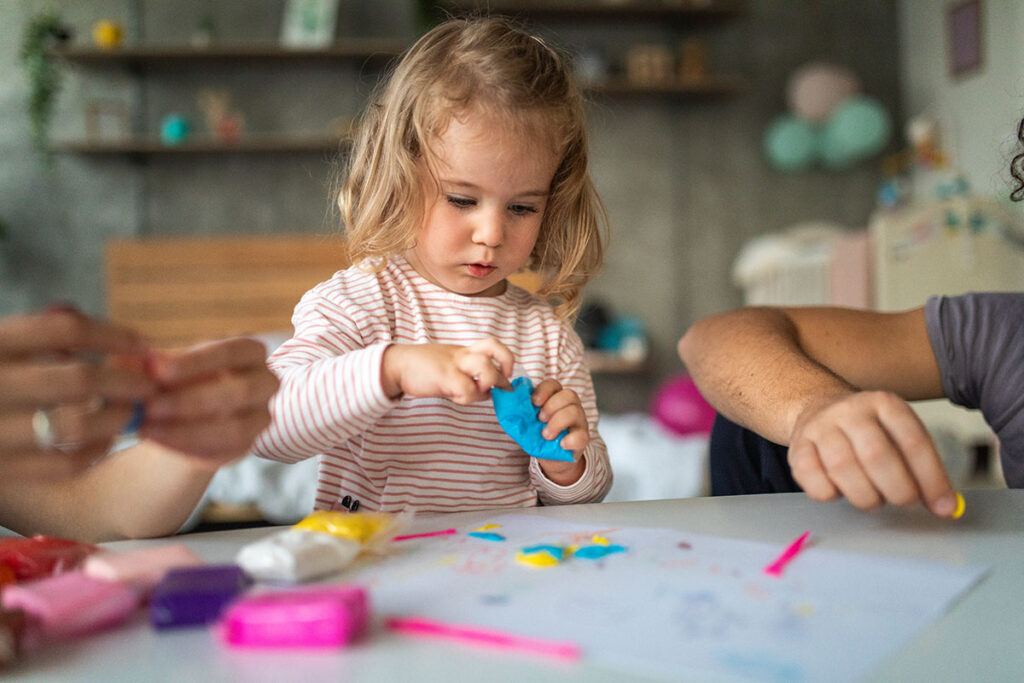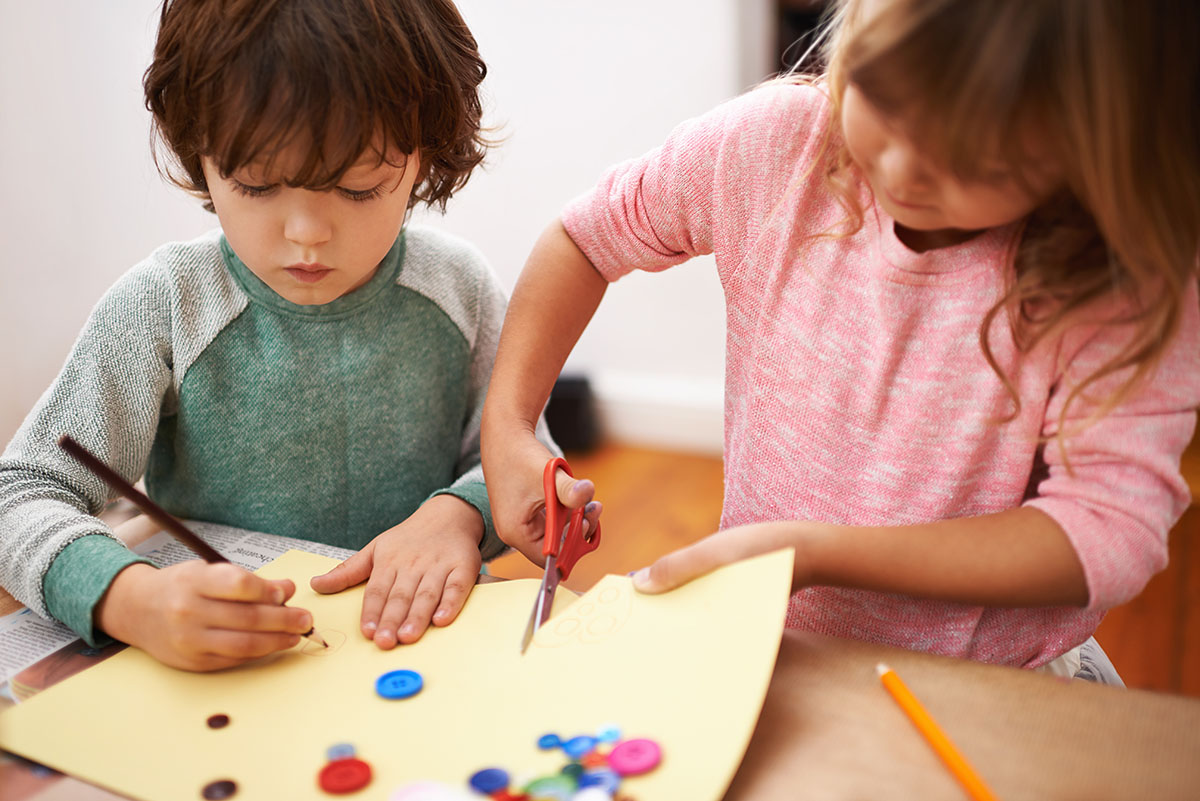Fine motor skills are a familiar term to most of us. However, few of us are aware of how much we rely on them in everyday life. We move our fingers and feet and change our facial expressions as a matter of course. But we don’t think about the fact that we first have to learn and train these small, delicate movements. This is precisely the challenge that every child faces. Their fine motor skills must first be properly discovered in infancy.
In this blog post, we will show you how important the development of fine motor skills is for children’s development and which fine motor skills exercise you can use to support your child.
Table of contents
- We can’t do without gross motor skills
- Promoting fine motor skills: Why is this so important?
- Promoting fine motor skills – with exercises that are fun!
We can’t do without gross motor skills
The development of gross motor skills, i.e. a person’s general movement skills, usually takes place entirely unconsciously. It already begins in the first month of infancy, when the infant lifts its chin. From then on, the development of gross motor skills progresses rapidly. The child learns to lift the chest, to sit and crawl, to stand, to walk by hand and finally to walk unaided. And often within its first 11 to 15 months – with each child developing at its own pace.
This happens most effectively when the child has enough space for freedom of movement.
The more space he has to explore and the more opportunities he has to try out his mobility, the better. And the more solid the gross motor foundation, the easier it will be to train fine motor skills.
However, the training of gross motor skills is by no means finished with free running! In fact, basic motor skills have only been achieved at school age. Regular exercise gives the child physical confidence and a wide variance of stimuli that helps the central nervous system to fully form. In addition, everyone who plays sports knows: Movement increases the body’s ability to coordinate! Therefore, it is also enormously important for school children to promote fine motor skills.
You can find more on the topic of gross motor skills and tips on how to support your child in their development in our blog post “Promoting gross motor skills – suggestions and game ideas”.
And why movement trains more than just your child’s physical skills, we explain in the blog post “Education through movement! The playground promotes learning”.
Promoting fine motor skills: Why is this so important?
More than just dexterity
Why it is worthwhile to promote your child’s fine motor skills is simply explained: Because they are needed for countless activities in everyday life. As soon as the delicate guidance of the fingers and the skilful coordination of both hands is required, fine motor skills come into play. For example, when tying shoelaces, buttoning a jacket, eating with cutlery and brushing teeth. The use of other fine muscles, such as those of the toes and face, also falls into the category of “fine motor skills”. Speech motor skills are fundamental here, as they are responsible for correct verbal articulation.
Independence in everyday life
Since the muscles grow steadily, especially in the early stages, the development of fine motor skills progresses rapidly. Fingers, however, do not show great dexterity from the beginning but need to be trained extensively. For example, children first learn the tweezer grip – the grip of the thumb and index finger that is used to pick up small objects. In addition, eye-hand coordination must be practised so that children learn to handle objects more precisely. At the latest in school, when it comes to learning to write, children need to be able to hold a pencil and guide it purposefully. So if you support the development of your child’s fine motor skills with finger exercises, he or she will be able to cope better in everyday life and master tasks more quickly in the future.
Note: Give yourself and your offspring time to develop fine motor skills and practise diligently. Now and then, it just takes a little longer. Especially the development of the so-called handedness takes time. Sometimes it is not until the eighth or even ninth year of life that you decide whether your child is right- or left-handed. So if the pencil wanders back and forth between the hands before then, this is quite normal and no reason to make a correction.

Promote fine motor skills – with exercises that are fun!
Different movement sequences are the key to success if you want to promote your child’s fine motor skills. The more the movements vary, the more muscles are trained. So it is best to provide a colourful mix of games that are not very similar in their sequence. Similar to other construction games, drawing and painting offer great training that promotes not only motor skills, but also the creativity of your child. We have collected five fine motor skills games that will help train your child’s dexterity and are also a lot of fun on top of that.
Thread the noodles
It doesn’t take much for this fine motor skills exercise: just a bowl full of penne noodles and a string. The noodles are then threaded onto these, one after the other. Small-scale work is great training for the fine motor skills of the fingers. Eye-hand coordination is also trained, as the hole in the noodle always has to be hit with the thread. If the chain has reached the desired length of your child, cut the cord and knot it. The pasta accessory is ready!
Tip: If you like it colourful, you can paint the pasta beforehand with a brush and paint or thread a few pearls between the pasta.
Modelling plasticine cacti
Modelling with plasticine is a great and fun way to develop the fine motor skills of the fingers. It doesn’t always have to be people or animals either. Plants can be shaped just as well. Cacti, for example! The body is formed from green modelling clay – either long or spherical – and with toothpicks cut in half, even the spines can be imitated. Adjusting the toothpicks is great for eye-hand coordination! If you like, you can model the plant pot at the same time, or put the plasticine plants in real, small pots to make the cacti look even more realistic.
Laying out pictures with burlap paper
Anyone can paint pictures in colour. Why not try “painting” with paper? It’s fun, and on top of that, you are safe from colour stains! For the plucked paper pictures, some coloured paper is cut into small pieces or simply plucked with the fingers. Then arrange the colourful snippets into motifs. If you stick them onto a sheet of paper with a little glue, you have a great picture “painted” – with paper! This is a great change from crayons and watercolours, trains the tweezer grip and encourages your child’s creativity on top of it all.
Painting with toe colours
Toe paints? What is that supposed to be? The same as finger paints, of course! The only difference is that you use your toes instead of your fingers. Take off your socks and dip them in! It’s easiest to paint on the floor. And with a bit of newspaper as a base, the splash protection is also taken care of. The result will probably end up looking a bit like expressionist art, but painting with your toes improves the mobility of your feet – and feels pretty fun too.
Making faces
It sounds like we’re pulling your leg, but it’s true: grimacing is a great way to exercise your facial muscles. The wilder the grimace, the more of the fine muscles are used. So, let’s go! Preferably in a race! Who can make the silliest face? Who can also wiggle their ears or even roll their tongue? Duck’s beak, smooching mouth and wrinkled forehead – all great for fine motor skills. The first one to laugh loses!
Promoting fine motor skills is practically child’s play. And as we all know, children learn best when they play. We explain which different types of play there are and how they help your child develop in our blog post “Play development in early childhood: What types of play are there?”.
Bild 1: PeopleImages / Signature Collektion / istockphoto.com
Bild 2: miodrag ignjatovic / Signature Collektion / istockphoto.com

